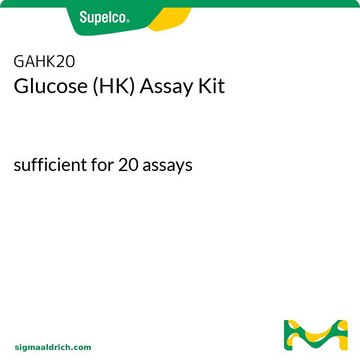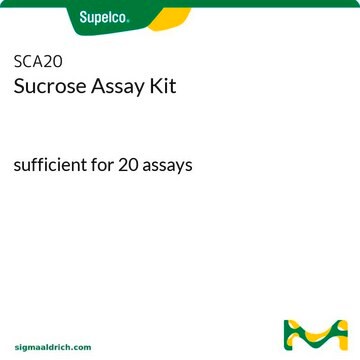MAK263
Glucose Colorimetric/Fluorometric Assay Kit
sufficient for 100 colorimetric or fluorometric tests
Faça loginpara ver os preços organizacionais e de contrato
About This Item
Código UNSPSC:
12161503
NACRES:
NA.84
Produtos recomendados
uso
sufficient for 100 colorimetric or fluorometric tests
aplicação(ões)
cosmetics
food and beverages
método de detecção
colorimetric
fluorometric
doença(s) relevante(s)
endocrinological disorders, diabetes
temperatura de armazenamento
−20°C
Descrição geral
Glucose is a primary energy source that naturally occurs in its free state in fruits and other plant parts. Abnormal glucose levels have been associated with several metabolic dysfunctions such as hypoglycemia, hyperglycemia, and diabetes mellitus. Measurements of glucose levels in tissues and body fluids (such as blood and urine) are often used for the diagnosis of glucose– related disorders. Glucose levels are also monitored to check the efficacy of therapeutics such as insulin and sulphonylureas in type 2 diabetics.
Características e benefícios
Compatible with high-throughput handling systems.
Adequação
Suitable for the determination of glucose concentrations in various biological samples, including serum, plasma, food, or growth medium. This kit is also suitable for monitoring glucose levels during fermentation and glucose feeding in protein expression processes.
Princípio
Glucose is oxidized to generate a colorimetric (570 nm)/ fluorometric (λex = 535/λem = 587 nm) product, proportional to the amount of glucose present. The kit is able to detect 1-10,000 μM of glucose in various samples.
produto relacionado
substituído por
Nº do produto
Descrição
Preços
Palavra indicadora
Danger
Frases de perigo
Declarações de precaução
Classificações de perigo
Aquatic Chronic 3 - Resp. Sens. 1
Código de classe de armazenamento
10 - Combustible liquids
Ponto de fulgor (°F)
Not applicable
Ponto de fulgor (°C)
Not applicable
Escolha uma das versões mais recentes:
Certificados de análise (COA)
Lot/Batch Number
Não está vendo a versão correta?
Se precisar de uma versão específica, você pode procurar um certificado específico pelo número do lote ou da remessa.
Já possui este produto?
Encontre a documentação dos produtos que você adquiriu recentemente na biblioteca de documentos.
Ryan K Perkins et al.
Nutrients, 11(3) (2019-03-03)
The purpose of this investigation was to evaluate the effects of experimental hyperglycemia on oxidative damage (OX), advanced glycation end products (AGEs), and the receptor for AGEs (RAGE) through an in vivo approach. Obese subjects (n = 10; 31.2 ±
Mike Boger et al.
Frontiers in cell and developmental biology, 10, 918529-918529 (2022-07-26)
The ELMO protein family consists of the homologues ELMO1, ELMO2 and ELMO3. Several studies have shown that the individual ELMO proteins are involved in a variety of cellular and developmental processes. However, it has poorly been understood whether the Elmo
Gemma K Kinsella et al.
International journal of molecular sciences, 22(19) (2021-10-14)
GPR21 is a constitutively active, orphan, G-protein-coupled receptor, with in vivo studies suggesting its involvement in the modulation of insulin sensitivity. However, its precise contribution is not fully understood. As the liver is both a major target of insulin signalling
Ye Du et al.
Frontiers in oncology, 10, 580176-580176 (2021-01-05)
Hypoxia is an important environmental factor and has been correlated with tumor progression, treatment resistance and poor prognosis in many solid tumors, including triple-negative breast cancer (TNBC). Emerging evidence suggests that long noncoding RNA (lncRNA) functions as a critical regulator
Abigail M Maucieri et al.
Biology of reproduction, 104(4), 914-923 (2021-02-08)
Glucose is a preferred energy substrate for metabolism by bovine granulosa cells (GCs). O-linked N-acetylglucosaminylation (O-GlcNAcylation), is a product of glucose metabolism that occurs as the hexosamine biosynthesis pathway (HBP) shunts O-GlcNAc sugars to serine and threonine residues of proteins.
Nossa equipe de cientistas tem experiência em todas as áreas de pesquisa, incluindo Life Sciences, ciência de materiais, síntese química, cromatografia, química analítica e muitas outras.
Entre em contato com a assistência técnica






